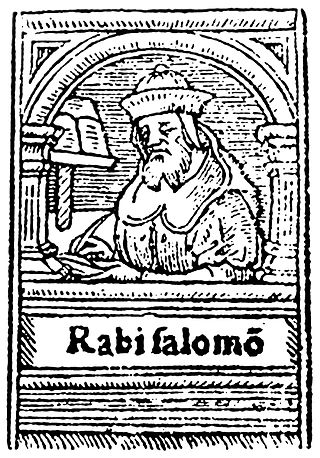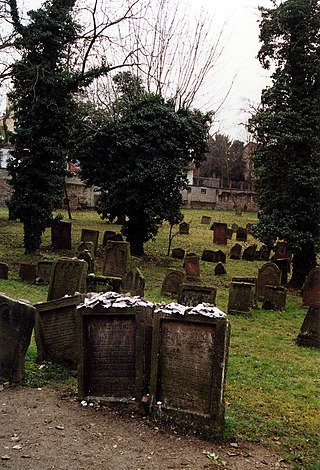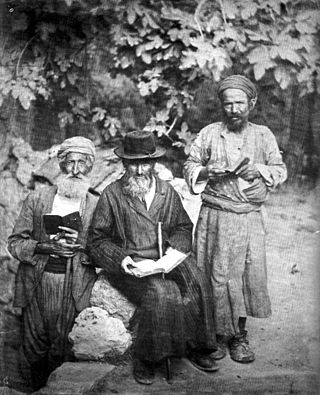Related Research Articles

Shlomo Yitzchaki, today generally known by the acronym Rashi, was a medieval French rabbi and author of a comprehensive commentary on the Talmud and commentary on the Hebrew Bible. Acclaimed for his ability to present the basic meaning of the text in a concise and lucid fashion, Rashi appeals to learned scholars and beginning students, and his works remain a centerpiece of contemporary Jewish studies. His commentary on the Talmud, which covers nearly all of the Babylonian Talmud, has been included in every edition of the Talmud since its first printing by Daniel Bomberg in the 1520s. His commentaries on the Tanakh—especially his commentary on the Chumash —serves as the basis of more than 300 "supercommentaries" which analyze Rashi's choice of language and citations, penned by some of the greatest names in rabbinic literature.

The Talmud is the central text of Rabbinic Judaism and the primary source of Jewish religious law (halakha) and Jewish theology. Until the advent of modernity, in nearly all Jewish communities, the Talmud was the centerpiece of Jewish cultural life and was foundational to "all Jewish thought and aspirations", serving also as "the guide for the daily life" of Jews.

Rabbinic literature, in its broadest sense, is the entire spectrum of rabbinic writings throughout Jewish history. However, the term often refers specifically to literature from the Talmudic era, as opposed to medieval and modern rabbinic writing, and thus corresponds with the Hebrew term Sifrut Chazal. This more specific sense of "Rabbinic literature"—referring to the Talmudim, Midrash, and related writings, but hardly ever to later texts—is how the term is generally intended when used in contemporary academic writing. The terms meforshim and parshanim (commentaries/commentators) almost always refer to later, post-Talmudic writers of rabbinic glosses on Biblical and Talmudic texts.

The Tosafot,Tosafos or Tosfot are medieval commentaries on the Talmud. They take the form of critical and explanatory glosses, printed, in almost all Talmud editions, on the outer margin and opposite Rashi's notes.
Daf Yomi is a daily regimen of learning the Oral Torah and its commentaries, in which each of the 2,711 pages of the Babylonian Talmud is covered in sequence. A daf, or blatt in Yiddish, consists of both sides of the page. Under this regimen, the entire Talmud is completed, one day at a time, in a cycle of approximately seven and a half years.

Shlomo ben Avraham ibn Aderet was a medieval rabbi, halakhist, and Talmudist. He is widely known as the Rashba, the Hebrew acronym of his title and name: Rabbi Shlomo ben Avraham.

Meir of Rothenburg (c. 1215 – 2 May 1293) was a German Rabbi and poet, as well as a major contributing author of the tosafot on Rashi's commentary on the Talmud. He is also known as Meir ben Baruch, and by the Hebrew language acronym Maharam of Rothenburg. He was referred to by Rabbi Menachem Meiri as the "greatest Jewish leader of Zarfat " alive at the time.

Solomon Buber was a Jewish Galician scholar and editor of Hebrew works. He is especially remembered for his editions of Midrash and other medieval Jewish manuscripts, and for the pioneering research surrounding those texts.

Menachem Mendel of Vitebsk (1730?–1788), also known as Menachem Mendel of Horodok, was an early leader of Hasidic Judaism. Part of the third generation of Hassidic leaders, he was the primary disciple of the Maggid of Mezeritch. From his base in Minsk Menachem Mendel was instrumental in spreading Hasidism throughout Belarus.
Samson ben Abraham of Sens ,was one of the leading French Tosafists in the second half of the 12th and the beginning of the 13th centuries. He was the most outstanding student and the spiritual heir of Rabbi Isaac ben Samuel ha-Zaken. He is referred also known as "the Rash" or "the Prince of Sens", and within Tosafot as "Rashba".
Samuel ben Isaac Ha-Sardi was a Spanish rabbi who flourished in the first half of the 13th century. In his youth he attended the school of Rabbi Nathan ben Meir of Trinquetaille, Provence, and later he returned to Spain, his native country. David Conforte derives the name "Sardi" from the city of Sardinia. Zacuto calls Samuel "Ha-Sefaradi"; so does Heilprin in Seder ha-Dorot, i.216b, 292a in the Warsaw edition of 1883, but in iii.108b of the Warsaw edition of 1882 he designates him "Ha-Sardi."

Rabbi Jonah ben Abraham Gerondi, also known as Jonah of Girona and Rabbeinu Yonah, was a Catalan rabbi and moralist, cousin of Nahmanides. He is most famous for his ethical work The Gates of Repentance.

Yisroel ben Shmuel Ashkenazi of Shklov was a Lithuanian Jewish Talmudist, one of a group of Talmudical scholars of Shklov who were attracted to Vilna by Rabbi Elijah ben Solomon Zalman, known as the Vilna Gaon (1720–97). He was one of "the last arrivals," and attended upon the Gaon as a disciple for less than a year.
Isaac ben Jacob Lattes was a rabbi who lived in Provence. In 1340 he wrote Toledot Yiẓḥaḳ, in which he gives valuable information concerning other Provençal authors and discusses the history of tradition. This work is known also by the name Sha'are Ẓiyyon. He wrote also Ḳiryat Sefer, a commentary on the Pentateuch.

Shabbat is the first tractate of Seder Moed of the Mishnah and of the Talmud. The tractate deals with the laws and practices regarding observing the Jewish Sabbath. The tractate focuses primarily on the categories and types of activities prohibited on the Sabbath according to interpretations of many verses in the Torah, notably Exodus 20:9–10 and Deut. 5:13–14.
Hachmei Provence refers to the rabbis of Provence, now known as Occitania, France that was a great Torah center in the times of the Tosafists. The phrase literally means the wise ones of Provence; hakham "wise one, sage" is a Sephardic and Hachmei Provençal term for a rabbi.
Rabbi Jonathan ben David ha-Kohen of Lunel was a leading French tosafist.
Solomon Sirilio (1485–1554), the son of Joseph Sirilio, was a rabbi and author of one of the first commentaries made on the Jerusalem Talmud.

Isaac ben Melchizedek, , was a rabbinic scholar from Siponto, Italy, and one of the first medieval scholars to have composed a commentary on the Mishnah, of which only his commentary on Seder Zera'im survives. Elements of the Mishnaic order of Taharot are also cited in his name by the Tosafists, but the complete work is no longer extant.
References
![]() This article incorporates text from a publication now in the public domain : Louis Ginzberg (1901–1906). "Abraham of Montpellier". In Singer, Isidore; et al. (eds.). The Jewish Encyclopedia . New York: Funk & Wagnalls.Jewish Encyclopedia bibliography: De Lattes, Sha'are Zion, ed. Buber, p. 42; Neubauer, in Rev. Ét. Juives, 1884, xvii. 53; Gross, Gallia Judaica, p. 326.
This article incorporates text from a publication now in the public domain : Louis Ginzberg (1901–1906). "Abraham of Montpellier". In Singer, Isidore; et al. (eds.). The Jewish Encyclopedia . New York: Funk & Wagnalls.Jewish Encyclopedia bibliography: De Lattes, Sha'are Zion, ed. Buber, p. 42; Neubauer, in Rev. Ét. Juives, 1884, xvii. 53; Gross, Gallia Judaica, p. 326.